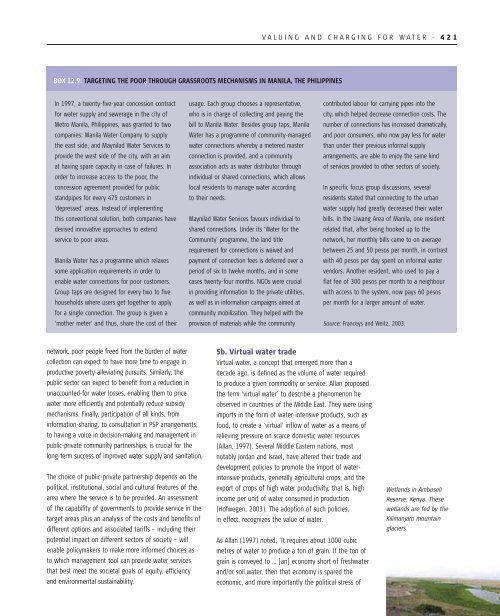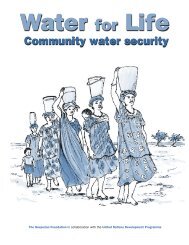Water: a shared responsibility; 2006 - UN-Water
Water: a shared responsibility; 2006 - UN-Water
Water: a shared responsibility; 2006 - UN-Water
You also want an ePaper? Increase the reach of your titles
YUMPU automatically turns print PDFs into web optimized ePapers that Google loves.
V A L U I N G A N D C H A R G I N G F O R W A T E R . 421<br />
BOX 12.9: TARGETING THE POOR THROUGH GRASSROOTS MECHANISMS IN MANILA, THE PHILIPPINES<br />
In 1997, a twenty-five-year concession contract<br />
for water supply and sewerage in the city of<br />
Metro Manila, Philippines, was granted to two<br />
companies: Manila <strong>Water</strong> Company to supply<br />
the east side, and Maynilad <strong>Water</strong> Services to<br />
provide the west side of the city, with an aim<br />
at having spare capacity in case of failures. In<br />
order to increase access to the poor, the<br />
concession agreement provided for public<br />
standpipes for every 475 customers in<br />
‘depressed’ areas. Instead of implementing<br />
this conventional solution, both companies have<br />
devised innovative approaches to extend<br />
service to poor areas.<br />
Manila <strong>Water</strong> has a programme which relaxes<br />
some application requirements in order to<br />
enable water connections for poor customers.<br />
Group taps are designed for every two to five<br />
households where users get together to apply<br />
for a single connection. The group is given a<br />
‘mother meter’ and thus, share the cost of their<br />
usage. Each group chooses a representative,<br />
who is in charge of collecting and paying the<br />
bill to Manila <strong>Water</strong>. Besides group taps, Manila<br />
<strong>Water</strong> has a programme of community-managed<br />
water connections whereby a metered master<br />
connection is provided, and a community<br />
association acts as water distributor through<br />
individual or <strong>shared</strong> connections, which allows<br />
local residents to manage water according<br />
to their needs.<br />
Maynilad <strong>Water</strong> Services favours individual to<br />
<strong>shared</strong> connections. Under its ‘<strong>Water</strong> for the<br />
Community’ programme, the land title<br />
requirement for connections is waived and<br />
payment of connection fees is deferred over a<br />
period of six to twelve months, and in some<br />
cases twenty-four months. NGOs were crucial<br />
in providing information to the private utilities,<br />
as well as in information campaigns aimed at<br />
community mobilization. They helped with the<br />
provision of materials while the community<br />
contributed labour for carrying pipes into the<br />
city, which helped decrease connection costs. The<br />
number of connections has increased dramatically,<br />
and poor consumers, who now pay less for water<br />
than under their previous informal supply<br />
arrangements, are able to enjoy the same kind<br />
of services provided to other sectors of society.<br />
In specific focus group discussions, several<br />
residents stated that connecting to the urban<br />
water supply had greatly decreased their water<br />
bills. In the Liwang Area of Manila, one resident<br />
related that, after being hooked up to the<br />
network, her monthly bills came to on average<br />
between 25 and 50 pesos per month, in contrast<br />
with 40 pesos per day spent on informal water<br />
vendors. Another resident, who used to pay a<br />
flat fee of 300 pesos per month to a neighbour<br />
with access to the system, now pays 60 pesos<br />
per month for a larger amount of water.<br />
Source: Franceys and Weitz, 2003.<br />
network, poor people freed from the burden of water<br />
collection can expect to have more time to engage in<br />
productive poverty-alleviating pursuits. Similarly, the<br />
public sector can expect to benefit from a reduction in<br />
unaccounted-for water losses, enabling them to price<br />
water more efficiently and potentially reduce subsidy<br />
mechanisms. Finally, participation of all kinds, from<br />
information-sharing, to consultation in PSP arrangements,<br />
to having a voice in decision-making and management in<br />
public-private community partnerships, is crucial for the<br />
long-term success of improved water supply and sanitation.<br />
The choice of public-private partnership depends on the<br />
political, institutional, social and cultural features of the<br />
area where the service is to be provided. An assessment<br />
of the capability of governments to provide service in the<br />
target areas plus an analysis of the costs and benefits of<br />
different options and associated tariffs – including their<br />
potential impact on different sectors of society – will<br />
enable policymakers to make more informed choices as<br />
to which management tool can provide water services<br />
that best meet the societal goals of equity, efficiency<br />
and environmental sustainability.<br />
5b. Virtual water trade<br />
Virtual water, a concept that emerged more than a<br />
decade ago, is defined as the volume of water required<br />
to produce a given commodity or service. Allan proposed<br />
the term ‘virtual water’ to describe a phenomenon he<br />
observed in countries of the Middle East. They were using<br />
imports in the form of water-intensive products, such as<br />
food, to create a ‘virtual’ inflow of water as a means of<br />
relieving pressure on scarce domestic water resources<br />
(Allan, 1997). Several Middle Eastern nations, most<br />
notably Jordan and Israel, have altered their trade and<br />
development policies to promote the import of waterintensive<br />
products, generally agricultural crops, and the<br />
export of crops of high water productivity, that is, high<br />
income per unit of water consumed in production<br />
(Hofwegen, 2003). The adoption of such policies,<br />
in effect, recognizes the value of water.<br />
As Allan (1997) noted, ‘It requires about 1000 cubic<br />
metres of water to produce a ton of grain. If the ton of<br />
grain is conveyed to … [an] economy short of freshwater<br />
and/or soil water, then that economy is spared the<br />
economic, and more importantly the political stress of<br />
Wetlands in Amboseli<br />
Reserve, Kenya. These<br />
wetlands are fed by the<br />
Kilimanjaro mountain<br />
glaciers
















